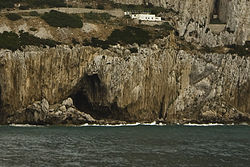Gorham's Cave
The cave is named after Captain A. Gorham of the 2nd Battalion Royal Munster Fusiliers, who discovered it in 1907 while opening a fissure at the rear of a sea cavern.
[4] Lieutenant George Baker Alexander, Royal Engineer and a graduate geologist from the University of Cambridge, arrived in Gibraltar in 1945.
The museum had no resources, however, so they forwarded his enquiry to Professor Dorothy Garrod at Cambridge, who had found a Neanderthal skull at Devil's Tower Cave during her earlier work in Gibraltar in the 1920s.
Garrod sought the assistance of Dr. John d'Arcy Waechter, a fellow of the British Institute of Archaeology at Ankara.
[6][7] Excavation of this site has resulted in the discovery of four layers of stratigraphy, one below the other: Accelerator mass spectrometry (AMS) dating gives dates for level IV of between 33 and 23 thousand years before the present (kyr BP)—the researchers felt that the uncertainties at this time depth made calibration impractical.
The scratches are thought to be at least 39,000 years old, because they were found below a layer of undisturbed sediment of that age in which hundreds of Neanderthal stone tools were discovered.
He suggests that the scratches could have been made by modern humans and subsequently been covered by older sediments shifting within the cave.
This behaviour was considered exclusive to modern humans and has been used as an argument to distinguish our direct ancestors from ancient man, including Neanderthals.
Other alleged examples of Neanderthal art have been found in other caves in Europe, including motifs in Spain, and possible "jewellery" in France.
The team researching the Gorham's Cave scratches sought to determine whether it might have been produced accidentally, for example as a by-product of using the rock as a surface for cutting meat or fur.
They decided that the lines were most likely created by using a pointed tool or cutting edge to scrape repeatedly along, and deepen, an existing groove, taking as many as 300 strokes and requiring at least an hour's work.
[1] In November 2010, the Gorham's Cave complex was put forward to compete for a nomination as a UNESCO World Heritage Site.
Professor Clive Finlayson, director of the Gibraltar Museum, was responsible for co-ordinating the efforts to obtain this nomination.
The first step was a proposal to the United Kingdom cultural authorities to get Gorham's Cave complex added to the UK's World Heritage tentative list.
[17] In May 2012 Gorham's Cave complex was on the short list of two sites, along with the Forth Rail Bridge, that was forwarded for submission to UNESCO.


